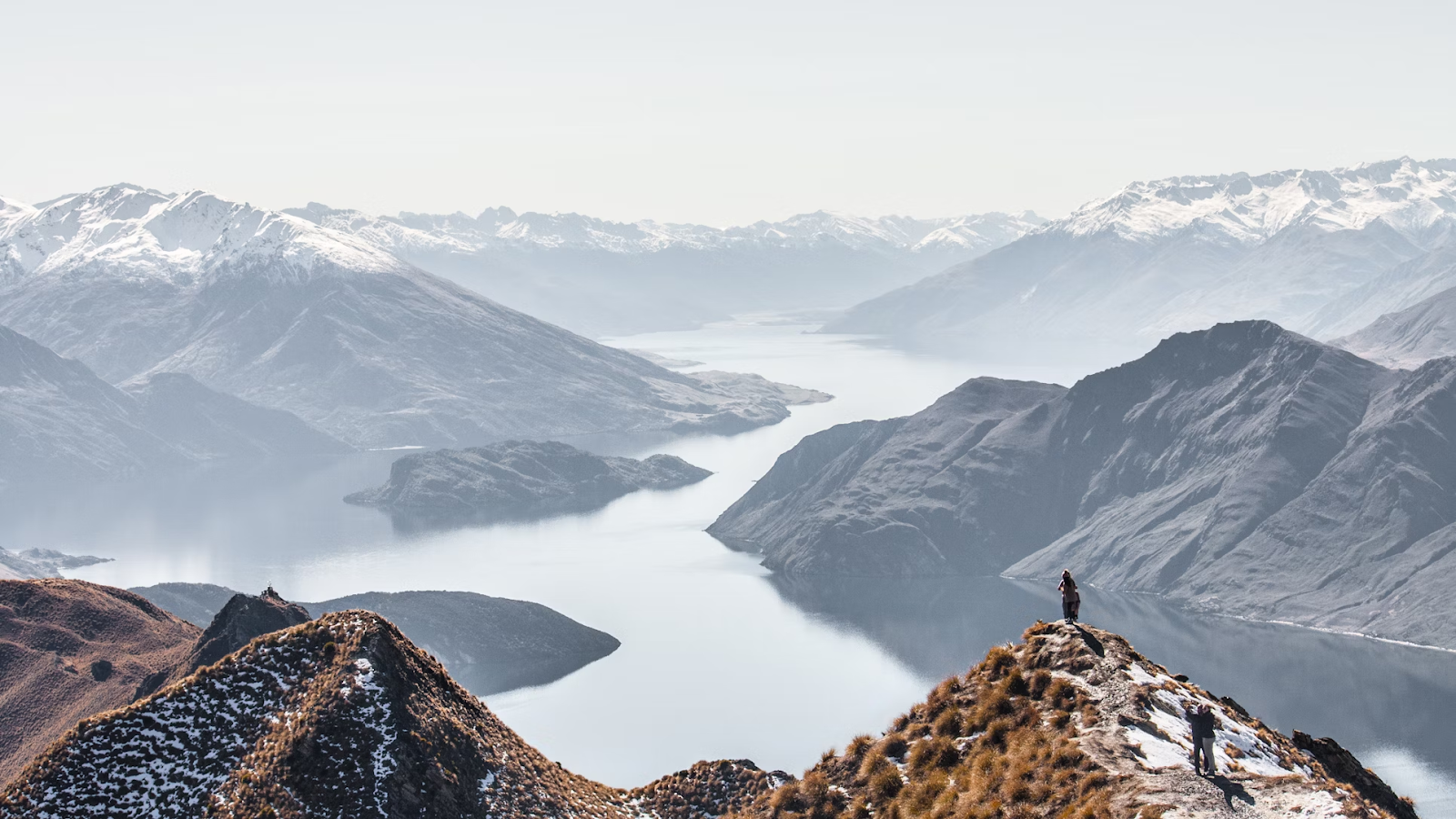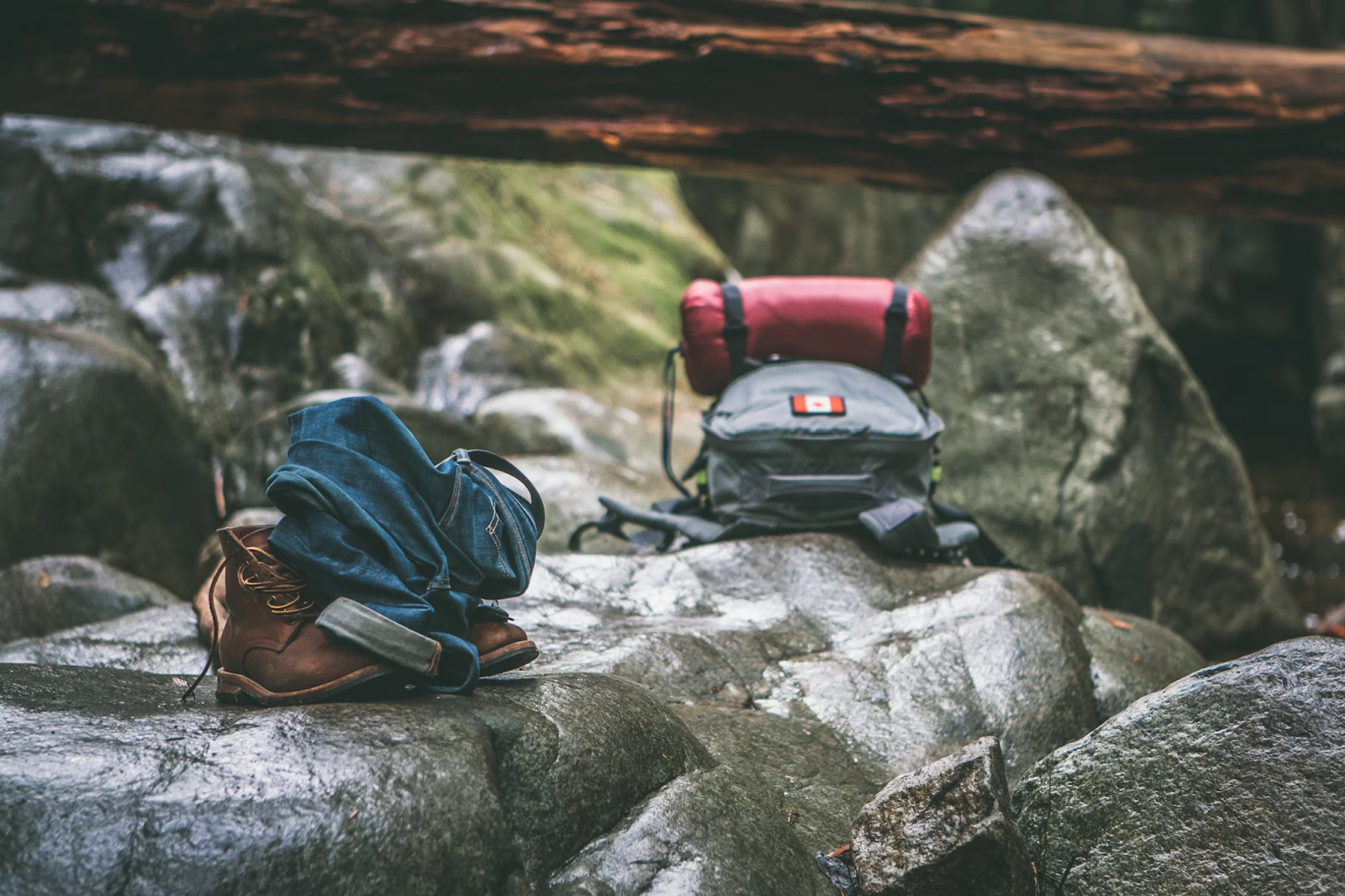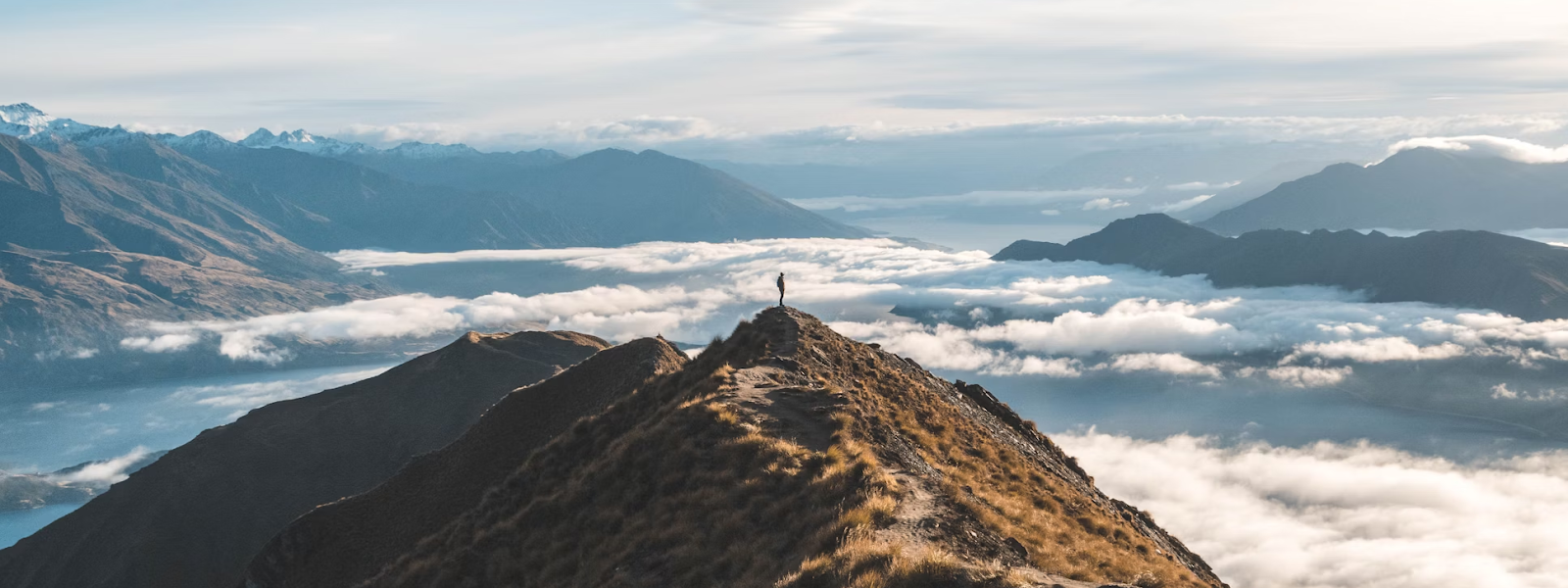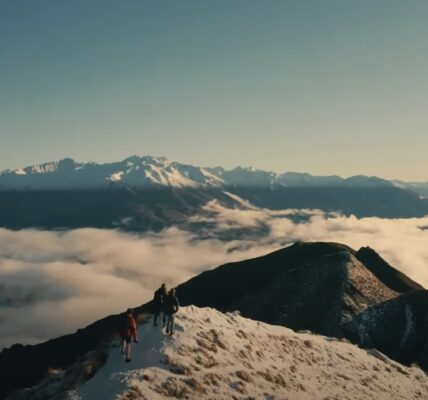When planning a trek in New Zealand’s South Island, hikers often find themselves choosing between two iconic trails: Isthmus Peak and Roys Peak. Both peaks offer stunning views, challenging trails, and unique experiences, making them popular choices among locals and tourists alike.
In this guide, we will explore the key differences between Isthmus Peak vs Roys Peak, helping you decide which hike is best suited for your next adventure. Whether you’re debating Roys Peak vs Isthmus Peak for your upcoming trek, this detailed comparison will provide you with all the essential information to make an informed choice.
Location and Accessibility: Isthmus Peak Location
Isthmus Peak is located near Lake Hawea in the Otago region of New Zealand’s South Island. The trailhead is accessible from State Highway 6, making it a convenient option for those traveling from Wanaka or Hawea. The drive from Wanaka takes approximately 30 minutes, providing a scenic route along the lake.
Getting to Isthmus Peak is relatively straightforward. From Wanaka, you can take State Highway 6 towards Haast, and after about 30 kilometers, you’ll find the turnoff for the Isthmus Peak track. There is a small parking area at the trailhead, which can get busy during peak hiking seasons, so arriving early is advisable.
Roys Peak Location
Roys Peak is situated closer to Wanaka, just a short drive from the town center. The trailhead is on Mount Aspiring Road, making it easily accessible for visitors staying in Wanaka. The proximity to the town makes Roys Peak a popular choice for those looking for a day hike without a long commute.
To reach Roys Peak, head out of Wanaka on Mount Aspiring Road for about 6 kilometers until you see the sign for the Roys Peak track. There is a designated parking area at the trailhead, but it can fill up quickly, especially during the summer months. Consider taking a taxi or shuttle if you want to avoid the hassle of finding parking.
Trail Overview: Isthmus Peak Trail
The Isthmus Peak track is a well-marked trail that spans approximately 16 kilometers (10 miles) round trip. Hikers can expect a steady ascent with some steep sections, offering a challenging but rewarding experience. The trail takes you through diverse landscapes, including farmland, tussock grasslands, and alpine regions.
The hike starts with a gentle climb through farmland, where you might encounter sheep and cattle grazing. As you ascend, the trail becomes steeper and more rugged, with several switchbacks to help manage the elevation gain. The final push to the summit involves a rocky scramble, but the panoramic views at the top make it all worthwhile.
Roys Peak Trail

Roys Peak track is slightly shorter, covering around 16 kilometers (10 miles) round trip. The trail features a relentless climb with switchbacks that offer little respite. Despite the challenging ascent, the trail is well-maintained and provides panoramic views throughout the hike. The peak itself offers breathtaking vistas of Lake Wanaka and the surrounding mountains.
The Roys Peak hike begins with a steep ascent right from the trailhead. The switchbacks can feel endless, but they provide a gradual incline that makes the elevation gain more manageable.
The trail is exposed, with little shade, so it’s important to bring plenty of water and sun protection. The final stretch to the summit is less steep, allowing you to catch your breath before taking in the incredible views.
Scenery and Views: Isthmus Peak Views
Isthmus Peak offers some of the most stunning views in the region. From the summit, hikers can enjoy panoramic views of both Lake Hawea and Lake Wanaka. The unique position of the peak provides a vantage point that captures the beauty of both lakes, making it a photographer’s paradise. On a clear day, the Southern Alps are visible in the distance, adding to the dramatic landscape.
One of the highlights of the Isthmus Peak hike is the 360-degree view from the summit. You can see the turquoise waters of Lake Hawea to the north and the deep blue expanse of Lake Wanaka to the south. The contrast between the lakes and the rugged peaks of the Southern Alps creates a breathtaking vista that is hard to beat.
Roys Peak Views
Roys Peak is renowned for its iconic views of Lake Wanaka and the Southern Alps. The summit provides a sweeping panorama that is often featured in travel brochures and social media posts. The ridgeline offers numerous photo opportunities, making it a favorite spot for sunrise and sunset hikes. The expansive views from the top are unmatched, offering a sense of accomplishment and awe.
The view from Roys Peak is nothing short of spectacular. From the summit, you can see the entire expanse of Lake Wanaka, with its many islands and peninsulas. The view stretches all the way to Mount Aspiring National Park, with its snow-capped peaks and glaciers. The sunrise and sunset from Roys Peak are particularly magical, casting a golden glow over the landscape.
Isthmus Peak Difficulty
The Isthmus Peak hike is considered moderately difficult due to its length and elevation gain. Hikers should be prepared for a steady climb with some steep sections. The trail can be challenging, especially in wet or snowy conditions, but it is manageable for those with a reasonable level of fitness.
Proper hiking boots and trekking poles are recommended to navigate the terrain safely. The elevation gain for Isthmus Peak is around 1,400 meters (4,593 feet), which can be demanding, especially if you’re not accustomed to steep hikes.
The trail is well-marked, but the terrain can be uneven and rocky in places. It’s important to pace yourself and take regular breaks to avoid overexertion.
Roys Peak Difficulty
Roys Peak is also classified as a moderately difficult hike, primarily due to its relentless ascent. The continuous climb can be strenuous, especially during hot weather.
However, the well-maintained trail makes it accessible for hikers with moderate fitness levels. The switchbacks help to manage the steepness, but the lack of shade and the exposed nature of the trail can add to the challenge.
The elevation gain for Roys Peak is around 1,300 meters (4,265 feet), which is slightly less than Isthmus Peak, but the continuous climb can feel more taxing. The lack of shade means you’ll be exposed to the elements for most of the hike, so it’s crucial to bring plenty of water, wear a hat, and apply sunscreen.
The trail is popular, so you can expect to encounter other hikers, especially during peak season.
Isthmus Peak Wildlife
Isthmus Peak is home to a variety of wildlife, including native birds such as kea, falcons, and paradise ducks. Hikers may also encounter small mammals like hares and stoats. The flora along the trail is diverse, with tussock grasslands dominating the lower slopes and alpine plants appearing as you ascend.
The lower slopes of Isthmus Peak are characterized by farmland, where you might see sheep and cattle grazing. As you climb higher, you’ll enter tussock grasslands, which are home to a variety of native plants and wildflowers. The alpine zone near the summit is more barren, but you’ll still find hardy alpine plants clinging to the rocky terrain.
Roys Peak Wildlife
Roys Peak offers similar wildlife encounters, with opportunities to see native birds and occasional glimpses of larger animals like deer. The flora is characterized by tussock grasslands and hardy alpine vegetation, with colorful wildflowers blooming in the spring and summer months. The presence of sheep and cattle grazing on the lower slopes adds to the pastoral charm of the landscape.
The flora and fauna of Roys Peak are similar to those of Isthmus Peak, with tussock grasslands dominating the lower slopes and alpine vegetation near the summit. You’ll likely see native birds such as kea and falcons, and if you’re lucky, you might spot a deer or two. The wildflowers in the spring and summer add a splash of color to the landscape, making the hike even more enjoyable.
Best Times to Hike

Both Isthmus Peak and Roys Peak can be hiked year-round, but the best times to hike are during the spring (September to November) and autumn (March to May) when the weather is mild and the trails are less crowded. Summer months (December to February) offer longer daylight hours but can be hot and busy, while winter hikes (June to August) require extra caution due to snow and ice.
Spring (September to November)
Spring is a great time to hike both Isthmus Peak and Roys Peak. The weather is mild, and the trails are less crowded than in the summer. Wildflowers are in bloom, adding a splash of color to the landscape. However, spring weather can be unpredictable, so be prepared for sudden changes and pack layers.
Summer (December to February)
Summer offers the best weather for hiking, with long daylight hours and warm temperatures. However, this is also the busiest time of year, so you can expect crowded trails and full parking lots. Start your hike early in the morning to avoid the heat and the crowds.
Autumn (March to May)
Autumn is another excellent time to hike, with cooler temperatures and fewer crowds. The fall foliage adds a beautiful backdrop to your hike, making it a great time for photography. As with spring, be prepared for variable weather and pack accordingly.
Winter (June to August)
Winter hikes can be challenging due to snow and ice, but they offer a unique and rewarding experience. If you decide to hike in winter, make sure you have the proper gear, including crampons and ice axes, and be prepared for cold temperatures. Check the weather forecast and trail conditions before heading out.
Accommodation Options Near the Trails
When planning your hike to Isthmus Peak or Roys Peak, it’s essential to consider where you’ll stay before and after your adventure. Wanaka offers a range of accommodation options to suit various budgets and preferences.
For those hiking Isthmus Peak, you can stay in the charming town of Hawea, which is closer to the trailhead. Hawea offers cozy lodges, bed and breakfasts, and holiday parks with beautiful views of Lake Hawea.
For a more extensive range of accommodations, Wanaka is a short drive away and provides hotels, motels, backpacker hostels, and luxury lodges.
Staying in Wanaka is ideal for those planning to hike Roys Peak. The town offers numerous accommodation options, from budget-friendly hostels to luxurious lakeside resorts. Wanaka’s central location makes it easy to access other outdoor activities and attractions in the region, ensuring a well-rounded adventure.
Tips for Hikers:
- Preparation: Ensure you have adequate water, snacks, and appropriate clothing for changing weather conditions. Layers are essential, as temperatures can vary significantly.
- Footwear: Wear sturdy hiking boots with good ankle support. Trekking poles can help with the ascent and descent.
- Start Early: Begin your hike early in the day to avoid the heat and crowds, especially during peak season.
- Check the Weather: Always check the weather forecast before heading out and be prepared for sudden changes.
- Leave No Trace: Follow the principles of Leave No Trace to protect the environment and preserve the beauty of the trails.
- Navigation: Carry a map and compass, or a GPS device, to help you navigate the trail. While both trails are well-marked, it’s always good to have a backup.
- First Aid: Bring a small first aid kit with essentials like band-aids, antiseptic wipes, and pain relievers. Blisters and minor injuries can happen, so be prepared.
- Hydration: Stay hydrated by drinking plenty of water before, during, and after your hike. Consider bringing a water filter or purification tablets if you plan to refill from natural water sources.
- Respect Wildlife: Observe wildlife from a distance and do not feed or approach animals. Keep to the trail to avoid disturbing their habitat.
- Photography: Both peaks offer incredible photo opportunities, so don’t forget your camera or smartphone. Early morning and late afternoon light provide the best conditions for photography.
Conclusion
Choosing between Isthmus Peak and Roys Peak can be a tough decision, as both hikes offer unique experiences and breathtaking views. Isthmus Peak provides a more diverse landscape with stunning vistas of two lakes, while Roys Peak offers iconic views that are hard to beat.
Ultimately, the choice depends on your preferences for trail difficulty, scenery, and proximity to Wanaka. Whichever hike you choose, you’re guaranteed an unforgettable adventure in one of New Zealand’s most beautiful regions.
In summary, whether you’re debating between Isthmus Peak vs Roys Peak or considering Roys Peak vs Isthmus Peak, both trails promise a memorable hiking experience. Take into account the specific features of each trail and your personal preferences to make the best choice for your next outdoor adventure.
By preparing adequately and respecting the natural environment, you’ll ensure a safe and enjoyable experience.







